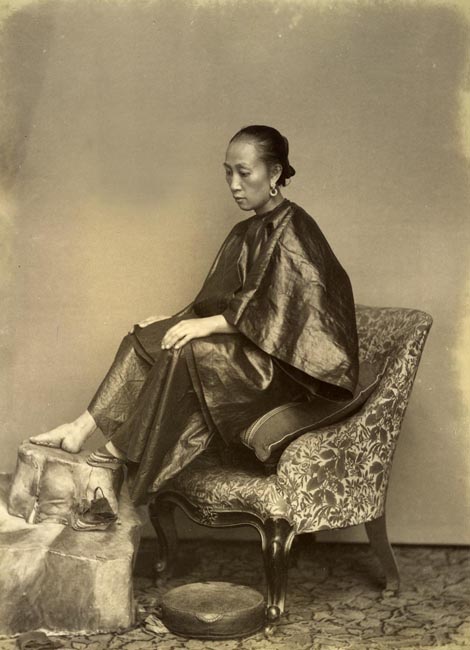“Because I bound my own feet, I could manipulate them more gently until the bones were broken. Young bones are soft, and break more easily.”-Wang Lifen
Chinese foot binding, a practice once viewed as a symbol of feminine beauty and high status, is now looked at as an example of female subjugation due to a culture shift. Although extreme, I like to think of foot binding in a similar way to corsetry, bum rolls,scarification, etcetera, because they all represent women catering to the cultural aesthetics of their time. Radical body modification has not become a thing of the past either! Women in developed nations today go under the knife in order to increase their beauty in the form of breast implants, liposuction, butt lifts, lip filler, and much more. Foot binding was an important cultural practice that began in China in the 12th century and was commonplace until the start of the 20th century. ‘Lotus feet’ as they were often called, were once a proud accomplishment for the women who had undergone the grueling process. Today, the historical method is seen as a shameful practice of brutality (Lim).

The origin story regarding foot binding speaks of a dancer who found favor with the Emperor after binding her feet into a hoof shape. She danced on a stage shaped like a lotus flower and the unique way she moved caught a lot of attention (Schiavenza). Bound feet were first popular in the royal court and amongst the wealthy, but just like with most trends, the lower classes eventually mimicked the practice in hopes of gaining better marriages and status. The smaller the foot, the more marriageable the woman was considered to be. In fact, a 3-inch foot was the most sought after and was called ‘the golden lotus’. Not only was it a beauty standard, but bound feet also became eroticised in Chinese culture. Foot binding even impacted fashion and architecture, with one story homes being popularized along with narrow streets which offered walls to lean on (Poole).

The Process:
It usually took between 2-3 years for a foot to be properly reshaped and it typically started when a child was 5 or 6 years of age. The foot was massaged with oils and soaked in water to soften the skin. Then all the toes, except the big ones, were broken and folded underneath the pad of the foot. The toes were held in place with tightly wrapped silk bandages. The girl was encouraged to perform physical exercises like walking and jumping with the bandages on in order to get the arch of the foot to break. The wraps were changed regularly and the foot was manipulated bit by bit until the desired shape was accomplished. In some cases, excess skin was cut off the feet in the hopes of obtaining a smaller shoe size. The feet could easily become infected and the wearer’s bandages stunk. Some women reported foul odors emanating from their wrappings their entire lives. Once the girl reached her teen years, the bones were done growing and the modification was permanent.

Although the practice was banned in 1912, a large sum of women continued to bind their feet secretly in order to attract husbands. In 1999, the last factory which produced lotus shoes closed and by 1949, foot binding had all but disappeared entirely. Women who underwent the grueling process had experienced an intimate intergenerational bond amongst the women who had lived through the same cultural experience. The self-inflicted disability was a symbol of pride and beauty and emphasized the daintiness of womanhood. Some women would go on to regret their decision to bind their feet, but many overlooked much of the inconveniences it caused in return for beauty. The lengths women have gone through, all throughout the course of history in the name of love and marriage, are truly fascinating!
Until Next Time
N.F.
Sources:
- Foreman, Amanda. “Why Footbinding Persisted in China for a Millenium.” Smithsonian. February 2015. 18 July, 2023. https://www.smithsonianmag.com/history/why-footbinding-persisted-china-millennium-180953971/.
- Lim, Louisa. “Painful Memories for China’s Footbinding Survivors.” NPR. 19 March, 2007. Accessed 18 July, 2023. https://www.npr.org/2007/03/19/8966942/painful-memories-for-chinas-footbinding-survivors.
- Poole, Jade. “The History Behind Foot Binding in China.” MyMed. Accessed 18 July, 2023. https://www.mymed.com/health-wellness/body-modifications/foot-binding/the-history-behind-foot-binding-in-china.
- Schiavenza, Matt. “The Peculiar History of Foot Binding in China.” The Atlantic. 16 September, 2013. Accessed 18 July, 2023. https://www.theatlantic.com/china/archive/2013/09/the-peculiar-history-of-foot-binding-in-china/279718/.